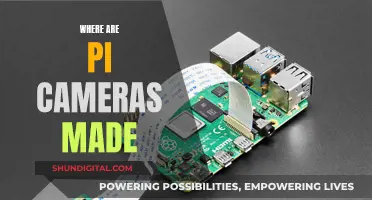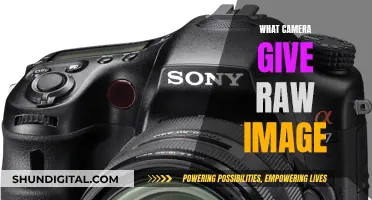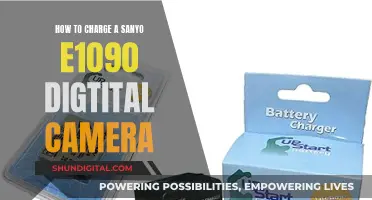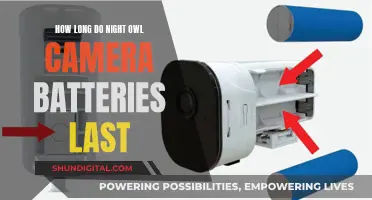
The first cellphone with a built-in camera was the Kyocera VP-210, also known as the Visual Phone, which was released in Japan in May 1999. It had a 0.11MP front-facing camera, a 2-inch colour TFT display, and could store up to 20 photos. However, it was only available in Japan for the PHS network. The first mass-market camera phone was the Sharp J-SH04, also known as the J-Phone, which was released in Japan in November 2000 and could send photos electronically.
| Characteristics | Values |
|---|---|
| Name of the first cellphone with a camera | Kyocera VP-210 |
| Date of release | May 1999 |
| Place of release | Japan |
| Price | 40,000 yen (~$325 in 1999, or about $521 today) |
| Camera resolution | 0.11MP |
| Number of pictures it could take | 20 |
| Display | Two-inch color TFT display supporting 65,000 colors |
| Camera type | Front-facing |
What You'll Learn
- The first camera phone was the Kyocera VP-210, released in Japan in May 1999
- The first camera phone with colour display was the Kyocera VP-210
- The first camera phone to send photos electronically was the Sharp J-SH04, released in November 2000
- The first US camera phone was the Sanyo SCP-5300, released in November 2002
- The first camera phone with a flash was the Sanyo SCP-5300

The first camera phone was the Kyocera VP-210, released in Japan in May 1999
The first camera phone ever to be sold commercially was the Kyocera VP-210, released in Japan in May 1999. It was also known as the Kyocera Visual Phone VP-210 or the Kyocera VisualPhone. The phone was priced at 40,000 yen, which was approximately $325 in 1999 or about $521 in 2024.
The Kyocera VP-210 featured a 2-inch colour TFT display supporting 65,000 colours and a single front-facing 110,000-pixel camera. It could store up to 20 JPEG digital images, which could be sent over email, or the phone could send up to two images per second over Japan's Personal Handy-phone System (PHS) cellular network. The phone even had its own integrated stand for taking selfies.
Although the Kyocera VP-210 was the first camera phone to be sold commercially, it was not the first camera phone to be created. In 1993, Daniel A. Henderson created two prototypes of a "wireless picturephone technology" device called the Intellect, now housed in the Smithsonian National Museum of American History. In 1995, Apple shared a design for a videophone that combined the look of the company's Newton PDA with a video camera and display. In 1997, Philippe Kahn created the first working camera phone by connecting a Casio QV-10 digital camera with an LCD display, a Motorola StarTAC flip phone, and a laptop.
Maximizing Comcast Business Cameras: Full-Screen View
You may want to see also

The first camera phone with colour display was the Kyocera VP-210
The VP-210 was a silver mobile phone with a 2-inch screen and a built-in front camera. It had a single front-facing 110,000-pixel camera and could send two images per second through Japan's PHS mobile phone network system. The phone could also take 20 photos and convey them by email. At the time, the camera phone retailed for 40,000 yen, which was about US$325 in 1999.
The development of the VP-210 began in 1997 at Kyocera's Yokohama research and development center. The project was initiated by Kazumi Saburi, one of the section managers, who envisioned a device that would allow people to talk to each other while being able to see each other's faces on the display. Kyocera's research showed that a "cell phone with a camera and colour display provided a completely new value for users". The VP-210 was the result of a two-year development campaign, during which a dozen engineers worked to overcome technical challenges related to the placement of the camera module within the phone and increasing its data transmission rate.
The Kyocera VP-210 played a significant role in the evolution of camera phones and set the stage for future innovations in this field.
The Standalone Camera Raw: Is It Possible?
You may want to see also

The first camera phone to send photos electronically was the Sharp J-SH04, released in November 2000
The J-SH04, also known as the Sharp J-Phone, was the third camera phone to hit the market. It was released in Japan by J-Phone (now SoftBank Mobile). The phone had a camera resolution of 0.11MP and could take photos at 110,000-pixel resolution.
One of the companies that helped with Sharp's efforts was LightSurf, founded by Philippe Kahn. Kahn was responsible for "MacGyvering" the first working camera phone in 1997. His wife was about to give birth to their first child, and he wanted to take pictures and share them with family and friends immediately. He created a hardware and software interface to connect a camera and a phone via a laptop. The first-ever cell phone camera image was a photo of his daughter, Sophie, which he was able to quickly share with 2,000 people.
The Sharp J-SH04 integrated the hardware of the phone and camera, unlike Samsung's SCH-V200, which was the second camera phone to hit the market. The Samsung SCH-V200 was released in South Korea in June 2000 and could take up to 20 photos at 0.35MP resolution. However, users had to connect the phone to a computer to transfer and send the photos.
Charging Your Fujifilm Camera Battery: How Long Does It Take?
You may want to see also

The first US camera phone was the Sanyo SCP-5300, released in November 2002
The first camera phone in the US was the Sanyo SCP-5300, released in November 2002. It was a groundbreaking device, featuring a dual-colour display and an integrated camera with a flash. The phone was a collaboration between Sanyo and Sprint, and retailed for around $400.
The SCP-5300 had a clamshell design and a 0.3-megapixel camera, which was considered impressive at the time. It could capture images at 640 x 480 pixels and included basic camera features such as a flash, white balance control, self-timer, digital zoom, and various filter effects. The phone also had a USB port for transferring and syncing data with a PC, although this required an optional cable.
The SCP-5300 was well-received, offering excellent phone features, sophisticated camera capabilities, and a smart, compact design. It played a significant role in popularising camera phones in the US, with over 80 million camera phones sold worldwide by the end of 2003.
Lorex Cameras: Low-Battery Alerts and Notifications Explained
You may want to see also

The first camera phone with a flash was the Sanyo SCP-5300
The Sanyo SCP-5300 was a groundbreaking device, as it was one of the first camera/mobile phones to hit the US market. It was a tri-mode CDMA phone with a dual-color display and an integrated camera with a flash. Other features of the phone included 1xRTT high-speed data, Java, voice dialing, voice memo, call screening, and PIM (organizer) capabilities.
The SCP-5300 had a 2.1-inch color TFT screen that could display 65,536 colors. It offered approximately 2.7 hours of talk time and about 10.5 days of standby time with the bundled battery. A high-capacity lithium-ion battery could further extend the talk time by 50%.
The phone had a circular, four-button navigation button and a center select button for easy navigation. It also came with action games like Missile Command, Reversi!, and Ms. Pac-Man. Additionally, it had a web browser, screen savers, SMS chat, and basic PDA features, including an address book and calendar.
The camera on the SCP-5300 could be accessed through a dedicated button above the number pad. The lens and flash were located on the outside of the clamshell case, and the LCD screen turned into a viewfinder when the camera was active. The phone also included a small LCD panel that showed phone status and turned into a mini-viewfinder when the camera was on.
While the SCP-5300 was a novelty at the time, the image quality of the camera was not impressive. The camera could only capture 640 x 480 images, and the built-in flash had a limited range of less than 3 feet. Despite this, the SCP-5300 was a significant step forward in the evolution of camera phones.
Samsung Galaxy S8: Night Mode Camera Feature Explained
You may want to see also
Frequently asked questions
The first cellphone with a camera was made in 1999. The Kyocera Visual Phone VP-210 was released in Japan in May of that year.
The Kyocera Visual Phone VP-210 had a 0.11MP front-facing camera, a 2-inch colour TFT display supporting 65,000 colours, and could store up to 20 JPEG images.
The first camera phone released outside of Japan was the Samsung SCH-V200, which was released in South Korea in June 2000.







